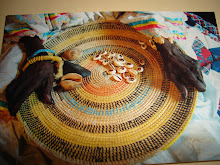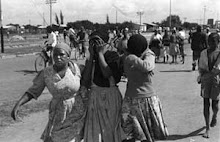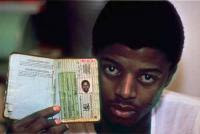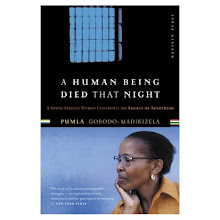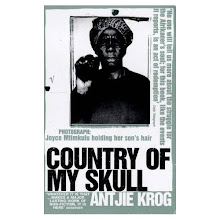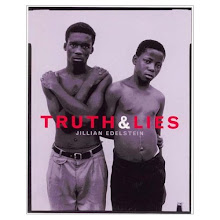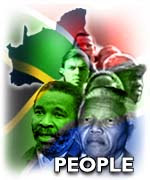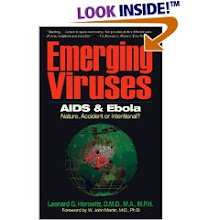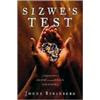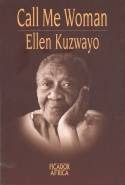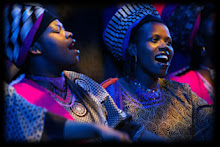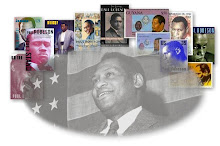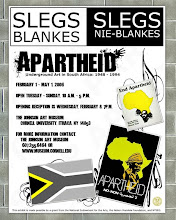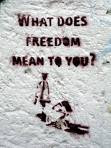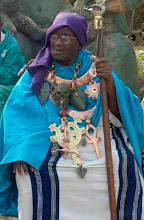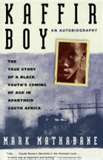 Fire the Heart Bushmen Living
Fire the Heart Bushmen Living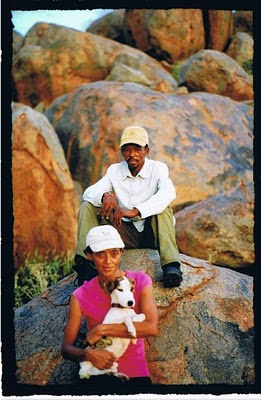 Belinda, Oeli and B the dog
Belinda, Oeli and B the dog
Devastation in Welkom after the Powerful ritual, trees uprooted
 Generations of the Kalahari River bed Children and First Peoples
Generations of the Kalahari River bed Children and First Peoples Children of the Kalahari and the First Peoples
Children of the Kalahari and the First PeoplesBuses are pretty reasonable here and cover long distances. There are several to chose from. We chose the Intercape bus which was R400 about $60. These buses are reasonably comfortable, air conditioned and safe. One or two are not particular safe although I think all is well with Baz Bus, Australian that stops at various places and you can hop on and off, Greyhound and Translux Unfortunately like the USA all transport have discovered a way to make money, charge for every ounce of luggage that is overweight. How can you be overweight on a bus? Anyway apart from the awful tea, and the fact that the temperature ran hot and cold according to how the driver wanted it and the religious brainwashing on the TV. It was okay.
When the bus pulled into Upington, I had a vision of this one road African town in days gone by. I knew Belinda right away when I saw her striding up to the bus. Small, slim brown as a berry from the desert sun and walking with a man who was remarkably tiny and slim, like her, my first sight of a bushmen. Politically correct term .....First People, some say Khoi San, or Khoi Khoi some say Bushman(thought derogatory in some circles, the debate still continues I believe.)
The man who shall be called Oeli (Oeliset) I shortened his name, as it took me a few days to pronounce, was fine being called a Bushman. Belinda and I fell into a natural hug, although we had never met each other, and only had email contact and 2 calls, she felt like a sister. Belinda is a bundle of energy. She did not stop talking from the minute we arrived. It was hard at first to follow her drift, she spoke clearly and in a very strong Afrikaans accent, Cape Colored she later introduced herself as. Oeli and her spoke Afrikaans I found in it a gentleness rather than the harsh gutteral sounds that in the past had made me broil and for some reason my ears and heart leaned towards what can be a rather ugly language. Oeli was a soft gentle soul and the language became softer and gentler the more I heard them speak. Surprisingly I began to understand more and more of it and even more shocking I started to speak it quite fluently. It would be the only way that Oeli would understand me, and as the time went on it turned out that we needed to have some lengthy conversations, as he adopted me as his Ma. He spoke several other African languages.
Belinda led us to her Buckie a 2 seater covered truck, and immediately suggested that I sit up front with her, and everyone else, three adults and Bea the dog settle in the back with all our luggage, neatly arranged by Oeli. I was told it was pretty hot back there. The temperature was a mere 41 degrees and we had not yet reached the heart of the Kalahari.
We were first taken to Belinda’s friend’s house, a famous artist, Walter pronounced Valter, where we were given tea and chocolate biscuits, and a well appreciated shower. We are asked if we wanted to stay overnight or keep moving.
Refreshed from our shower and excited, we opted to keep moving after a sit down meal in a restaurant, all of us were peckish. At this point I had introduced my fellow travelers to Marie biscuits one of them did remember her New Zealand grandmother having them with butter and cheese, just as my grandmother had eaten them! And so Maries became our food of comfort, when in doubt have a Marie and a cup of tea! They are a semi sweet crispy biscuit (cookie for my USA brothers and sisters) that tastes quite creamy in a way. I think you can find them in the “ethnic” section of some delis in the USA.
I had a farm breakfast, Boervoors a kind of very long sausage quite tasty. Traditionally it would be braii (barbecued) and often made with beef and herbs, sometimes game, Springbok or Ostrich (which I do not eat) 2 fried eggs, tomatoes, toast, mushrooms and Five Roses tea, the mainstay of my culinary needs and occasionally a cup of African Rooibos (Red Bush tea) Which I heard the USA tried to claim as their invention, and lost the case, go figure. Watered, grazed and ablouted (If there is such a word) and a stop at the supermarket for food supplies, we all jumped back in the buckie and so began our journey into the Kalahari.
Belinda began to unravel her amazing story and her life with the Bushmen. I would like to suggest an extra ordinary read, Kalahari Rain Song written by Belinda (Kruiper) about her journey, and how she came to meet the Riverbed Children, of the Kalahari. She lived her life with them and finally married a bushmen called Vetkat a talented young artist who tragically died in his thirties of a ruptured lung. His artwork still lives on and the week after we left Belinda and Oeli were traveling to Kimberly where Vetkat’s work was being exhibited. What an honoring in his name to be remembered in this way. I just spoke to her. The exhibition went well and she was recognized for her powerful storytelling and her message of honoring the old ways and practicing them as a necessary part of healing.
On two occasions Belinda has received the woman of the year award in South Africa, although it is not something she would mention herself. Belinda has always worked tirelessly and continues to do so for the protection and preservation of art, artifacts and cultural heritage of the First Peoples, to remain alive in our hearts and to ensure that those who came before are remembered so that those who come after are taught the traditional ways. Credo Mutwa would call it Holy work. It is has been a long journey for her with much struggle and strife, and she just keeps on going, in this time though I see that there is a major breakthrough. Often what we want and what we need do not always align, and when we truly follow the ancestors breath and whisperings in the wind we are shown other ways, ways that are not always where we think we want to go.
It is her time now, to shine and step into her greatness. Don’t be fooled by those small bones she is as strong as an Ox and a powerful woman.
The indigenous people of southern Africa, whose territory spans most areas of South Africa, Zimbabwe, Lesotho, Mozambique, Swaziland, Botswana, Namibia, and Angola, are variously referred to as Bushmen, San, Sho, Basarwa, Kung, or Khwe. These people were traditionally hunter-gatherers, part of the Khoisan group and are related to the traditionally pastoral Khoikhoi.They have provided a wealth of information for the fields of anthropology and genetics, even as their lifestyles change. (Wikepedia)
There is much written about the bushmen, San, Khoi Khoi (First Peoples) and so I will not attempt it here, some of it is subjective and derogatory. To look into their eyes,and see the small formed faces, bones and limbs, is to look deep into another world. It is as though you are falling in and there is always an invitation to know them, to know their story, to know their pain, their song, to know where they have come from and where they have been and to know that their hearts are buried deep in the land and all that holds. To take away their land is to take away the very life force that is their love and survival.
We headed to Welkom (pronounced Velkom) first to Belinda’s house where we were to pack various items for our time in the Desert. I was excited to see the red sand dunes so common to the Kalahari. It was dry and hot as is expected, and it was something else.......Magical. There is something Divine in seeing the vast empty space of red sand and sky, and to imagine men hunted with bows and arrows, gathered and lived in such a simple way and some still do (more later) and were the first people. I carried this feeling of gratitude and blessing into the journey and still do.
Alongside the road we stopped at a crossroads where we spotted a couple of small open dwellings more like shade , made of straw/grass. Here sat three or four women one was in traditional dress, bare breasted a straw skirt and a necklace across her chest. The others were dressed in regular clothes. The man had on a very small soft suede loin cloth and a fur headpiece and noting else. They were introduced to us as Isa and Betty and were the River Children (although they were not children,) who sit alongside the road selling their arts and crafts. Bows and arrows, necklaces made of bone beautifully engraved with artwork that looked so delicate and ancient. Horn and bones were used a lot. There was something extraordinary deep about all their eyes, I was fascinated by the bone structure of their body and especially their face. Strong angular jaws with high cheekbones. Dark dark brown skin like beautiful tanned leather exceptionally smooth and tiny limbs that were sinewy and looked strong. These were the people who walked for miles and had the ability to shape shift into the animals they were hunting.
A young boy at about the age of 12 called !Xanan (yes thats the spelling) let us in to the gate and we were greeted by 3 more dogs, wanting to know from Bea, the (spoilt one) where she had been. I later found out that he lived with Belinda, and looked after the place when they were gone. His mother, worked at the Park and came home once a month. This is common it seems this sharing of and looking after children in the townships. !Xanan is a beautiful boy, very independant and responsible. His mother had asked Belinda to look after him now and she has agreed, he is very pleased
We entered the town of Welkom and close to each town is the place where you will find the township, where the people were removed to from the white areas. This is where Belinda had set up home. It had red sand for streets which fell naturally into their order as houses had been built. Not a large township by any means, the houses were mostly brick. Belinda’s house was unusual in that it had a Kraal around it and a sheltered area in the back where fire was often made. Fire the heart of the Bushmen living. It was what we sat around and talked, cooked on, using sturdy iron pots of various sizes, boiled water, cooked tasty stews, boiled rice, and brewed medicine, anything was cooked on the fire in these black cast iron pots. And it tasted good. An iron triangle was sometimes placed on top of the fire to hold the pot. Water was collected in a water tank, sometimes there was water sometimes there was not. The floors were stone in the main house and Belinda’s bedroom where I slept that night was a corrugated iron structure separate from the main house. The floor was red sand! It was lovely and cool to the touch, if you dared walk bare feet. Many thick slug looking long black creatures, slid along the sand. They are called the rain worm, and appear just before the rain comes. Considered sacred they have a beautiful song that they sing called the Kalahari Rain Song.
The houses were divided by trees or shrubbery. There was a liquor store and 2 shops which sold mostly tinned and dried goods. And horses and horsedrawn carts were still used as transport! It felt rather surreal to have a neighbor draw up on a horse and speak to you over the fence!
Some of the people in this tiny township appeared unwelcoming in Welkom. Welkom consists of a colored population with some bushmen/women. Oppression (the bushmen were referred to as rubbish) and its medication, alcohol and Dagga has killed the spirit of the people. Spirit our fire when out of control shows up as violence or can literally burn out no flame or ember, a deep grief, deep depression and no zest for life. I saw both in the eyes of the people in Welcom. TB is a major killer in South Africa the disease that can accompany HIV. The lungs in Chinese Medicine is associated with grief. The grief is tangible in Welkom, its in peoples’ eyes. Some of the young men and women seemed to stagger slightly, slurring their words as they spoke, their eyes red with dagga or too much cheap booze. My heart hurt when I saw them and I felt helpless for the first time on my trip.
There was a sort of despondency, doom, a lost cause. For !Xanan to survive and come out unscathed by his predecessors was a miracle. That is all we can ask for, that at least one child/ youth is supported to lift them selves out of a situation that has been passed down, that was forced upon them. To lose ones land, to an African is to disconnect from one’s true nature. To lose one’s ground is to uproot ones very foundation. To loose one’s cattle and lively hood, is to lose one’s survival. In addition their women were raped, they were raped or abused. To survive and still pull one’s self up is not the measure of an animal, as was often a term used to describe the First People but the measure of a real man, and strong and resilient woman. They say if you are still here, then you must really want to be here. But despite those bold words, I did not see much hope in the faces that did not greet me in Welkom township. We left the next day and my heart felt sore.
We drove deeper into the Kalahari, and what was called the park that Belinda had worked. Here Botswana and South Africa are separated by the riverbed (dry) When we drove on the Botswana side we were not allowed to step out of the truck. This was hard for Oeli whose nature it is to track and walk.
The Kalahari a place of unforgiving climate, a burning sun and a moon that is the only light that breaks the foreboding darkness once a month, and when that happens porcupines are hunted. Along the way ostriches ran across our paths their long necks flailing as if they would snap at any moment. Herds of Gemsbok grazed and drank at the water hole, a lone turtle waddled across the road, and suddenly we heard a banging from the back Stop !!!! They were pointing to a tree a few feet under which lay a lion. His back was towards us, but his head was up. Oeli climbed higher onto the truck and began what I saw a most delightful goading of the king of Animals. It was in Afrikaans but I understood and so did the lion! Oeli’s face lit up and his smile widened and his voice became childlike as he gently and playfully chided with this amazing animal. What I noticed was the utmost respect as though he was talking to a grandfather. Everything looks large in the desert, Belinda said, it is because of the vast landscape.
Ou Baas (old Boss) he called to the lion, hey Ou baas, get up and look at us. Hey ! ! Get up lazy, turn and look at us, come on what’s wrong with you, no time to sleep. We could see the lions ears twitch and lift as he heard the sound of the voice. Finally he turned to look at us got up and walked away. It was not the last we would see or hear from him.
We arrived at our destination called Roi Puts a campsite with 4 places to set up. There were just two other people already at theirs. Oeli laid a stake at the site for protection and very soon we were amazed to see how in a matter of minutes he had disappeared across the Veldt (desert) and was later seen a long long way away. I wondered quietly to my self how he had gotten so far in such a short space of time, as I swear I had not seen him walk there. I will leave that to the readers imagination but suffice to say that in the desert magic is always in the air and shape shifting happens on a regular basis as they transform to hunt their animals.
We set up the tent, lit a fire arranged our food and settled in for the evening. Whole squash, beets and potatoes were wrapped in foil and Oeli taught us how to ashbake. After the wood had turned to embers he dug a hole, placed the wrapped vegetables in the hole and covered it with hot ash and placed the coals on the top.
Whilst we waited for them to cook we sat and talked and Oeli patiently answered all our questions. The Afrikaans was translated by Belinda and we were fascinated by the stories of medicines found in the plants and trees, hunting and healing and the old ways. We unwrapped our very hot foil packages and ate hungrily. They were good!
Because of the possibility of lions visiting to check us out on their way to or from the waterhole we were coaxed to sleep in our tent as opposed to under the stars and Belinda and Oeli took the back of the truck.
It is where the sky on a clear night opens to twinkling stars that can seem so close you could touch them and the animal sounds woo and frighten you. It is truly in awe that I was taken and it was breathtaking. Here it is said that people suddenly disappeared carried by a wind, or struck by lightning or bitten by a poisonous snake or scorpion. Some survived to tell a story and others were left hanging in a tree, by a lion. I witnessed Oeli come alive at the sight of an animal, speaking to them like children and goading them. It is their game when they hunt to see who will survive. Even with torch light you are not sure what is lurking behind you. You have to have the protection of the Gods with you. It’s vastness is all consuming and deeply freeing all at the same time, especially at night where you are completely exposed and vulnerable. For some reason I find this exhilarating. I felt the same feeling when I crossed the vastness of reservations in the USA, and I now know why I have always had a calling to the desert. Snakes are my fear and therefore my medicine and I trod with apprehension both in daylight and at night.
Mirages appear and shadows loom apparently to warn of animals but only those educated in the ways of this sacred land would know its signs and its mystery. It is a lonely landscape often offering little in sustenance, and as described in Belinda’s book often un -relentless in its teachings but the land the vegetation and the animals were regarded with deep respect by those who inhabited it. In early times and still in certain places the land is inhabited by families who sing and dance and share the fire. Stories are shared and enjoyed and loved by all, smoking was and is a sacred pastime, and at one time waterholes were owned and passed down through the generations.
It seems that in certain areas there is a still an abundance of rock art as part of their spiritual expression however what came through the teachings of this gentle man and Belinda was that all life in the veldt, included their spiritual expression, hunting, ritual, the elements, song, animals dance, art work, building a kraal or hut. All of this was what was depicted in the rock art. What I gleaned from my very brief taste of this veldt (desert) was that every inch of it from the red sand that ran through my fingers to the bark on a tree and a man walking with a stick, or the fire that was the heart of their family life was not only sacred but held in it magic. And I wanted more of this great emptiness and its magical teachings.
The next day we rose early to hot tea, bananas and marie biscuits. We were off on a game drive, and a visit to the beginnings of the veldt school that Belinda and the river bed children had dreamed. Along the way we saw springbok, gemsbok, ostrich sometimes all hanging out at the water hole together. After a very long, very bumpy drive we finally crossed over to the South African side and drove through a sign that said do not enter. We arrived at the beginnings of the Veldt school a kraal had been built by some of the river bed children (not children) , it was surrounded by sand dunes. It was here that Belinda wanted to provide the teachings of the Bushman to the youth and children to help them remember the spirit and traditions of the old ways and preserve them.
We sat and talked and walked a little and finally returned back to the park for cold drinks.
As we drove from the park a grinding noise came from the truck and I suggested we return to the garage in the park to take a look. No book ins had to be done. Belinda knew everyone along the way and they agreed to look and fix right there the brake we had lost and for no charge! While we were there we met a man who was working on the road who was also staying at the camp. Later that evening he drove by and told us the lion was right by the side of the road. When game is around people tend to know their whereabouts and it is customary to spread the word so to speak. We jumped in his truck went up a do not enter road and sure enough there it was just two feet away from us lying (yes you guessed , under a tree) We watched Ou baas the same lion for about half an hour took photos and then left. it was amazing ! Before we parted the man told us that he (the lion) was pretty laid back but to take care as he was likely on his way back from the water hole and may come by our tent later that night to check us out. He also told us that the lions girlfriend was not as peaceful and had attacked his truck! Great...... thanks for sharing.
I gave Oeli a massage for his heavy lungs and was surprised at the strength he carried in his tiny body. Later he told me that I had come to him to represent his mother and from that day on he referred to me as Ma. It was very touching to have this 50 year old man calling me Ma. It was then that my Afrikaans somehow took on a new life as I found words that I did not know I knew and I talked with my new found son in Afrikaans.
That night there was a keen alertness at our camp. Oeli jumped up from time to time to shine his torch around us. THE OLD ONES SAY that the roar of a lion is so loud and one must have courage to survive it, as it has been known that men have died of heart attacks when they have heard it. We stayed out as long as possible and then we heard the roar. It sounded fairly close and I was shocked that it was as far away as the water hole! Now I understood what the old ones say. Because if that lion had been close to us it would have been so loud it would had stopped my heart! Belinda and Oeli told us to quickly bundle into our tent, and we did, I was thankful not to be sleeping alone. That night we all were awake with a little thrill in the air as we waited for the king to make himself known. The roar came a little louder as it began its journey across the veldt to warn humans that he was there and also to let other lions know where he was. Of course every rattle and crackle and movement outside the tent sent my heart fluttering but I felt protected all the time and never once felt in danger. It was good knowing that we had with us someone who knew this veldt intimately, yet still respected the dangers of the unknown. He did not pay us a visit that night, but he was close very close and we received his medicine.
Belinda awoke asking if I would do a ritual a clearing of all energies that were not good for her and Oeli. I said I would think about it what to do.
We took our last game drive, and were rewarded by witnessing two cheetahs mating way off in the distance on the top of a sand dune. I was surreal and strong medicine.
We returned to camp, packed our stuff and I performed the ritual for them. It was very moving, performed close to the graves of his parents.
We headed out before the noonday sun. On the way out we were rewarded again by our protector who had been with us since the day we arrived. Ou baas the lion was sitting under a tree alongside the side of the road bold as you like. SO close we looked into his eyes and could have touched him, and as our eyes stretched several more feet there she was, the girlfriend, her head up majestic and magnificent! We thanked him for his medicine both Belinda and I were tearful. Thank You old baas. One of the road workers was walking unafraid out there close to both lions, what a gift. What an incredible morning. Magic followed us everywhere we went in the veldt, the animals, the rituals, the medicine, the messages that were received in dreams and the deep wisdom carried by our very special guides.
Happy we drove from the park, and within minutes we headed to the Ompolomo Lodge for our first hearty meal in three days after which we returned to Welkom, where a thunderstorm was brewing in the place where energies were not wholesome. The old ones say when rain, especially heavy rain comes after ritual the prayers have been received. We dropped Oeli while we went back to the park for showers. We were gone no more than half an hour, and by the time we had returned we witnessed puddles along the road that the heavy rain had brought. We did not see any rain on our way to the park. As we entered Welkom Belinda’s mouth dropped, what happened here Slowly we started to see the devastation, trees had been uprooted, even a couple of roofs had come loose. But we were only gone half an hour........Belinda looked at me and together we understood the ritual had taken . That night Oeli made a fire, we cooked a vegetable stew with rice and we sat in the kraal and talked. A very windy night blew all the cobwebs away
The next morning we had a breakfast of eggs and fruit salad and went to say goodbye t a couple of people who sat around a fire smoking . It was clear that they had very little. We headed out to another farm to meet an elder, a woman who still spoke the ancient Language
We had arranged to spend the night with the Kalahari Rain Children that Belinda had spent most of her life with. It was the day before Valentines Day. That day each sign and symbol as we tried to visit blocked our way, until we reached the dwelling of one of the Leaders Isac. It was there I witnessed the devastation of internalized oppression.
The alcoholism and the violence. As I entered the hut I was greeted with a deep wailing that rocked my bones as it came from a place of such pain. And I saw those eyes change from the wisdom of the first peoples to a plea for salvation and again I was helpless. Leaving the hut I began to sense danger and I asked that we leave. I was not willing to stay in the chaos. We slept under the stars restless and uncomfortable. All of us drenched and soaked and yet it was a cold night. The ancestors were working hard to cleanse us. That morning we arose to be greeted by a deadly scorpion, seen by Oeli who gently sacrificed it to the fire in an honoring way, later a poisonous lizard appeared and that night we slept with the bats.
We headed towards Upington in the hope that our two friends could swing a wedding, they had decided to get married the night before. Finally we reached Upington, where we secretly shopped for a few wedding gifts for the couple, just in case, and we then went to see the justice of the peace. Unfortunately a document was needed which they did not have and we decided to go ahead with the gift giving later that night. We bought champagne and brand new sheets, a blues shawl candles, and two bone pieces that had been carved by one of Belinda’s favorite artists. We stopped overnight at an old farm Belinda knew run by Afrikaaners in Spitskop She said they had always been supportive of the Bushmen. On the farm was an old stone cottage with no electricity or water which Oeli and Belinda took and we slept in a one room hut with a thatched roof.
We prepared the gifts secretly whilst they sat outside and talked. It was a beautiful few moments when we presented them with our offerings. To honor a union was such a sweet ending to our adventure and the Magic of our Kalahari Experience. That night I was kept awake listening and watching the bats who lived in the rafters of the thatch swooping around our room. Some say they represent transformation, the bushmen say otherwise, I’ll take the transformation. The next morning we boarded the bus to Johannesburg. Our faithful taxi driver Johannes was there to meet my fellow travelers to return them to their hotel for a night and their flight home to the USA the next day, and I was met by a complete stranger, a friend of Belinda that she had made contact with who met me at the bus station and took me to his house where his wife had prepared a delicious meal of chicken, potatoes and squash.
I took a wonderful hot shower and listened to stories of their life and the next day was taken to the airport to catch my flight to George, and my next adventure in Wilderness.





